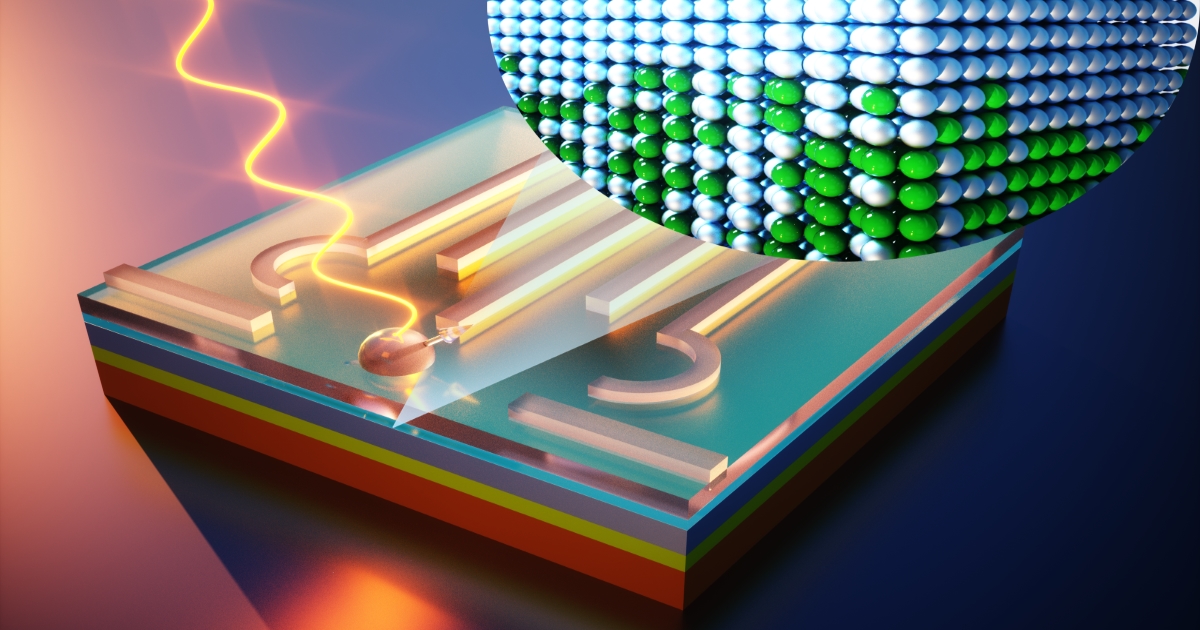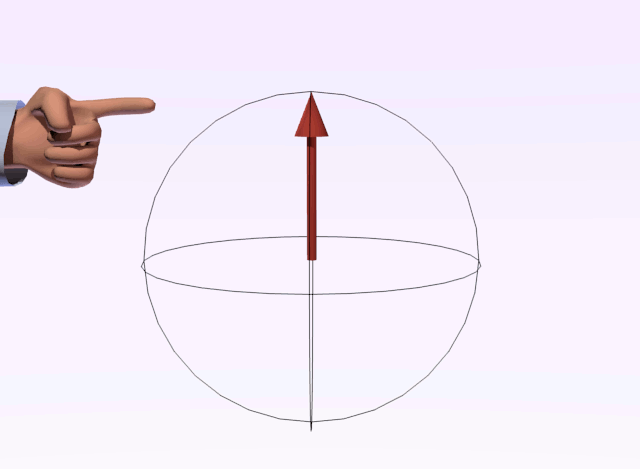Blogue
Quantum technologies: tiny holes for big information storage


Illustration accompanying the Advanced Materials article by Professor Moutanabbir's team, which discusses how the spin state of a germanium electron could be modified by laser light (credit: Nanoscopic and Quantum Semiconductor Laboratory).
While others are focusing on diamonds or superconductors to develop the first quantum technologies, Professor Oussama Moutanabbir's team is envisaging a third path: that of elementary semiconductors based on silicon, germanium, and tin. In a newly published article in Advanced Materials magazine, The group has just demonstrated a new way of manipulating "quantum information" in germanium structures on a silicon chip – a particularly interesting development, because it builds on existing production technologies.
Until a few years ago, making a phone call to a foreign country via land lines meant that the conversation would be accompanied by delays between each speaker. At the time, our communications were already based on fiber optics and light pulses capable of circling the earth in 130 milliseconds, but it was very far from perfect.
How come? Well, the signals passed through copper wires and electrical devices that were much less efficient at circulating information. Fortunately, this problem has now been solved by replacing those copper wires with fiber optics. A similar problem still occurs within our computers: they may exchange information via fiber optics, but they still process and store it via electrical and magnetic signals.
That’s why quantum computing is expected to be a game changer, replacing electricity with light and the magnetic properties of atoms. Researchers working on it have already passed the proof-of-concept stage, and they’re now looking to perfect these powerful, innovative tools.
A glance at... quantum computing |
|
Rather than storing data in semiconductors or magnetic disks in the form of "bits", quantum computers store information in atoms themselves - "qubits” - by changing and reading the angle at which an electron or other particle turns on itself. This angle is called its "spin.” This technology makes it possible to multiply the amount of information hidden in a memory unit. Rather than offering two options (1 or 0) as is the case with a “bit,” a qubit can theoretically exist in a hundred or more different positions, since the state of a particle's spin can be changed and read. Computers based on this technology will therefore perform calculations faster, but above all will be able to store an astronomical amount of data. So far, quantum engineering researchers have made great strides based on two approaches: the first involving diamonds, and the second involving superconductors. In the first case, imperfections in the crystal of diamond carbon atoms are used to store and read a qubit using a laser and microwaves. The technology shows great promise, but its large-scale production seems impossible. Superconductors are used to create a magnetic field around the electron of a targeted atom in order to control its spin state. Google, Intel, and IBM (among others), are banking on this very strategy. Yet there's a catch: in order to work, the targeted atom must be kept at a temperature close to absolute zero, or -273 degrees Celsius. Polytechnique Montréal Full Professor Oussama Moutanabbir (Department of Engineering Physics), is part of an international group of researchers pioneering an alternative approach that stands out from others, due to the ease with which it can be implemented. |
a hole-lot of information storage
 Professor Oussama Moutanabbir (Photo : Polytechnique Montréal)
|
In their recently published paper “A Light-Hole Germanium Quantum Well on Silicon” which appeared in Advanced Materials, Professor Moutanabbir's team demonstrates how germanium could be used to develop qubits that can interact with optical photons. The breakthrough opens the door to interfaces that bridge the worlds of quantum and optics to manipulate quantum information and transmit it over long distances in optical fibers.
It certainly sounds complex, and it is rather difficult to conceive of, but in this case, the information is not stored in the spin of an electron. Instead, it is locked in the spin of a place left vacant by an electron and behaves like a quasi-particle. Scientists refer to it as a "heavy hole" or a "light hole," but to better understand it, one could imagine a simple air bubble spinning on itself in the center of a glass of water.
"These holes have the advantage of being much less affected than electrons by all the magnetic and energetic noise around them," explains Professor Moutanabbir. "The quantum environment of the hole is much quieter.”
Without going into too many nuanced details, in the article, the Polytechnique Montréal team demonstrated how they could effectively manipulate the "quantum state" of light holes by using new germanium and tin alloys to create germanium quantum wells by introducing a tensile stress (tension) into the material. These quantum wells were directly integrated onto silicon chips. This represents an important advance, because until now, scientists have focused their attention on "heavy holes" in germanium - quasi-particles whose interaction with light don’t reliably retain the quantum information to be read, notes Moutanabbir.
However, there’s still a long way to go to make germanium and Group IV SiGeSn semiconductors the means for developing the quantum computers of tomorrow. "We’re several years behind those working with superconductors," admits Professor Moutanabbir.
However, he sees niches where this technology could be quickly adopted, such as "quantum repeaters", intermediate stations along a route that would be used to copy information and transport it without loss from point A to point B.
a quantum future in semiconductors?
Although not as far along as diamond or superconductors, semiconductors have a distinct advantage over the other two when it comes to imagining ways to manufacture these technologies on a large scale.
"The microelectronics industry has made it so that semiconductors on silicon wafers are already very well mastered," Moutanabbir says. "So we could make large-scale quantum devices with the same processes."
The Montréal region already has all the infrastructure at Polytechnique Montréal and McGill University to manufacture semiconductors for academic research purposes, he points out.
So what's the next step? Professor Moutanabbir hesitates. "There’s still a lot of work to be done and we don't know where to start.” With the support of the Canada Foundation for Innovation, Québec's Ministry of Economy and Innovation, the Ministry of National Defence (IDEaS), NSERC, PRIMA Québec and Canada Research Chairs, the engineer is working to put in place the equipment needed to test the technologies he’s developing, in order to take this new concept to the next level. "We hope to attract major players in the semiconductor industry to set up specialized infrastructures to study, for example, the interaction of qubits and qubit arrays with optical photons," Moutanabbir notes.






Comments
Commenter
* champs obligatoire